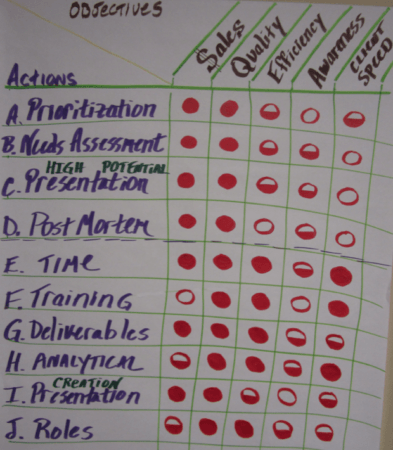When you facilitate alignment, you help groups identify gaps, omissions, and overkill, and confirm the appropriateness and balance of their action plan.
Rationale to Facilitate Alignment
Method to Facilitate Alignment
First of all, create a matrix with your options (e.g., actions) and the targets (e.g., goals). Common items that may be aligned include the comparison of strategies to objectives. To facilitate alignment, consider these three steps:
- First, complete the matrix with a linear approach, but be careful to always ask the open-ended question, “To what extent does ‘x’ (i.e., option, action, or strategy) support ‘y’ (i.e., target, goal, or objective) ?”
- Having defined the PowerBalls (preferably with a legend that is visible throughout the activity for your participants to reference), label each cell with either a high, low, or moderate PowerBall symbol, indicating the extent to which the option supports the target.
- While completing the matrix, ask the group to confirm completeness. Add anything missing or modify as required (i.e., Create a new option or calibrate an existing option).
Note: Since the solid balls indicate high and the empty circles indicate low, the half-filled balls indicate moderate. We like to define High as mandatory, “must have at any price.” We define Low as “would like to have but not willing to pay extra.” The stuff in between is Moderate, the stuff for which we would be willing to “pay a reasonable amount.” The equivalent to the MoSCoW tool would be: Must have, Should have, Could have, and Won’t have (null).
For seasoned professionals and alumni, consider using the Book-end method to equal dispersion after you complete your initial baseline analysis.
______
Don’t ruin your career by hosting bad meetings. Sign up for a workshop or send this to someone who should. MGRUSH workshops focus on meeting design and practice. Each person practices tools, methods, and activities every day during the week. Therefore, while some call this immersion, we call it the road to building high-value facilitation skills.
Our workshops also provide a superb way to earn up to 40 SEUs from the Scrum Alliance, 40 CDUs from IIBA, 40 Continuous Learning Points (CLPs) based on Federal Acquisition Certification Continuous Professional Learning Requirements using Training and Education activities, 40 Professional Development Units (PDUs) from SAVE International, as well as 4.0 CEUs for other professions. (See workshop and Reference Manual descriptions for details.)
Want a free 10-minute break timer? Sign up for our once-monthly newsletter HERE and receive a timer along with four other of our favorite facilitation tools, free.
Related videos
-
Basic Facilitation Skills: #1 How to Facilitate Alignment using Power Balls and a Decision Matrix
-
Basic Facilitation Skills: #2 How To Facilitate Consensual Prioritization with a Decision Matrix

Terrence Metz, president of MG RUSH Facilitation Training, was just 22-years-old and working as a Sales Engineer at Honeywell when he recognized a widespread problem—most meetings were ineffective and poorly led, wasting both time and company resources. However, he also observed meetings that worked. What set them apart? A well-prepared leader who structured the session to ensure participants contributed meaningfully and achieved clear outcomes.
Throughout his career, Metz, who earned an MBA from Kellogg (Northwestern University) experienced and also trained in various facilitation techniques. In 2004, he purchased MG RUSH where he shifted his focus toward improving established meeting designs and building a curriculum that would teach others how to lead, facilitate, and structure meetings that drive results. His expertise in training world-class facilitators led to the 2020 publication of Meetings That Get Results: A Guide to Building Better Meetings, a comprehensive resource on effectively building consensus.
Grounded in the principle that “nobody is smarter than everybody,” the book details the why, what, and how of building consensus when making decisions, planning, and solving problems. Along with a Participant’s Guide and supplemental workshops, it supports learning from foundational awareness to professional certification.
Metz’s first book, Change or Die: A Business Process Improvement Manual, tackled the challenges of process optimization. His upcoming book, Catalyst: Facilitating Innovation, focuses on meetings and workshops that don’t simply end when time runs out but conclude with actionable next steps and clear assignments—ensuring progress beyond discussions and ideas.




